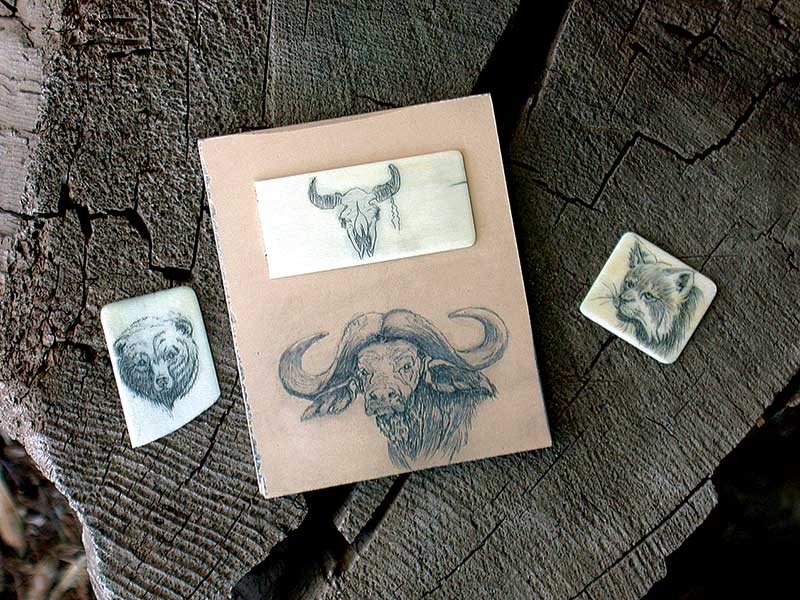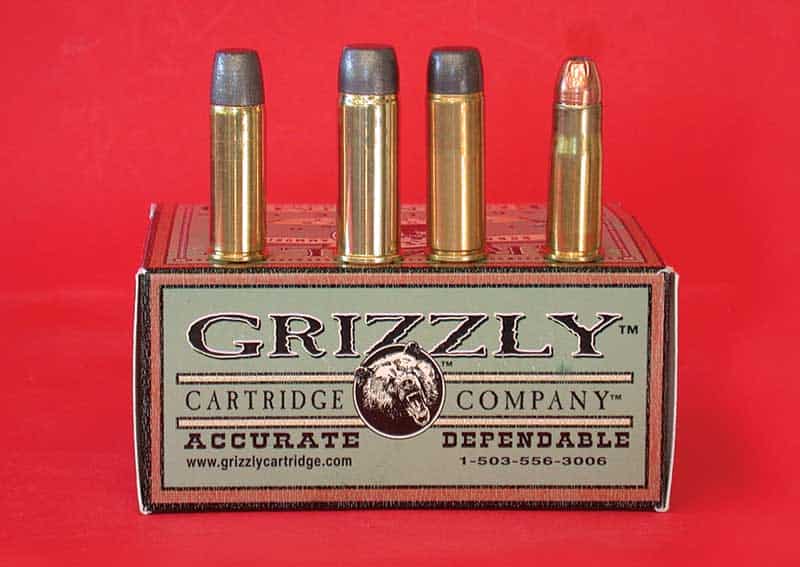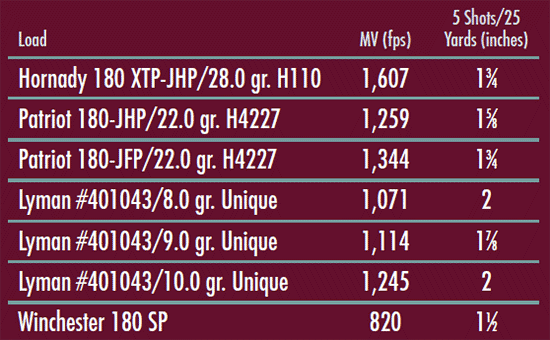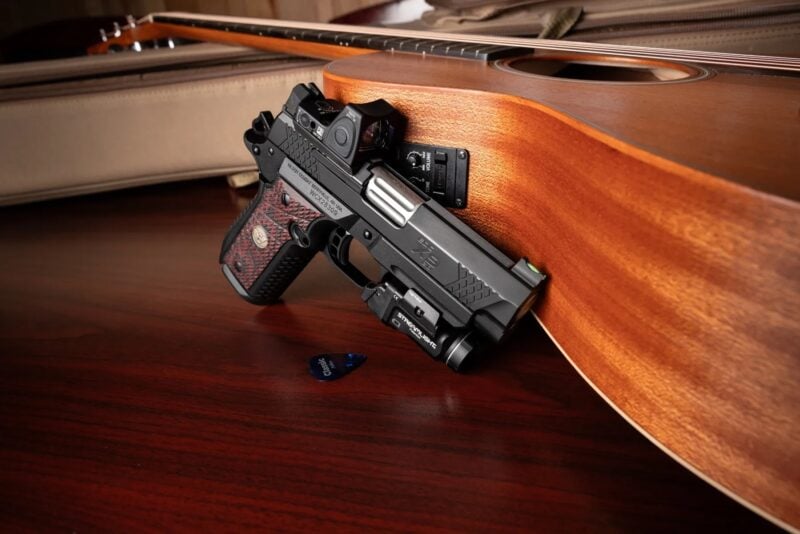The Sixguns Of John Linebaugh
The Man Who Wrote The Book On BIG!
Phone calls are like Christmas packages; until they are opened we don’t really know what awaits us. Once in a while either one can be life changing. Little did I know when I answered the phone on that Fourth of July in 1983 how much it would affect my future. This was before caller ID so I didn’t know the call was emanating in Cody, Wyoming from a young custom gunsmith calling to tell me about the custom .45 Colt sixguns he was building and to tell me he wanted to send me a test gun. His claims were extreme: A .45 Colt capable of shooting 250-grain bullets at 1,700 feet per second? This was at a time some were actually in print still calling .45 Colt brass weak!
New Doors
At the time I had been shooting the .45 Colt for more than 25 years. I was 17 when I bought the first 71⁄2″ 2nd Generation Colt SAA to arrive in my area in 1957, followed by one of the very first .45 Ruger Blackhawks in the early 1970s. The latter gun set new standards for the .45 Colt and allowed me to shoot 300-grain bullets at 1,200 fps. Little did I know what doors were about to open for me. The caller was custom gunsmith John Linebaugh and he sent me one of his custom .45s built on an El Dorado frame with a new 101⁄2″ barrel and oversized cylinder. The cylinder used up all the frame window possible and also was extended so there was no excess gap between the front of the cylinder and the frame.
That particular gun and loads were written up in American Handgunner (Jan/Feb, 1985), in fact it was the first article I did for Handgunner. I was very skeptical and perhaps I should have had more faith in Linebaugh, but at the time I did not know him. Since then he has become a good friend and also proven to be a top gunsmith, and a man who can be believed when it comes to big-bore single actions.
Using that first .45 Colt Linebaugh custom revolver, bullets of 260-grains, both cast and jacketed, were driven over 1,700 fps; 310- grain bullets to 1,565 fps; 325-grain bullets to 1,600 fps; and 385-grain bullets to 1,300 fps. Now remember at the time I was using a “Heavy Load” of 300-grain .45 Colt bullets at 1,200 fps. John’s sixgun added over 350 fps to that muzzle velocity. That experience made me a believer in John Linebaugh and his custom guns.
One of the main keys to the success of Linebaugh’s sixguns was, and is, close tolerances. Brass from factory .45 Colt loads expands .004″ or more in many factory chambered .45 Colt single-action sixguns; John’s custom .45s, even with heavy loads, expand only .001″ in diameter above the base of the cartridge, the pressure being contained by the tight cylinder rather than the brass.
Really Big Bore
In those early years Linebaugh built custom five-shot .45s on both Ruger and Abilene/Seville frames. Because of the grip frame designs then available felt recoil was extremely heavy. A remedy arrived in 1986 to not only help control Linebaugh’s heavy .45 Colt loads, but also to allow entry into the really big bores making a giant leap from the .45 caliber all the way up to .50 caliber with the .500 Linebaugh. That remedy was Ruger’s Bisley grip frame which for most of us is mandatory on really hard-kicking single action sixguns.
The .500 Linebaugh is based on the .348 Winchester case trimmed to 1.400″. At .50 caliber, actually .511″, the .500 Linebaugh is at the outer limits of caliber size in a packable pistol. To get the .500 into a packin’- sized gun, it’s necessary to discard the standard-sized Ruger Bisley cylinder and go with an oversized five-shot cylinder as six .50 caliber holes will not fit in a standard-sized cylinder and allow enough metal between chambers for safety. Five shots allows the bolt cut to be placed between, rather than under, cylinder chambers. With the advent of the .500 Linebaugh it was now possible to drive 400- to 440- grain bullets 1,200 fps or more using heavy charges of slow-burning pistol powders such as H110, a heavy crimp, strong neck tension on the bullet and magnum pistol primers.
How Big Is Big?
I rarely ever quote muzzle energy figures as I put very little stock in them. They are skewed against relatively slow-moving heavyweight bullets and for lightweight-bulleted, fast stepping loads. Linebaugh goes to Africa and the experience of a well known elephant hunter using a different formula for figuring true sixgun power, namely John “Pondoro” Taylor’s Knock Out formula. Caliber times Bullet Weight times Velocity divided by 7,000 equals “Knock Out.” Muzzle energy figures do not take caliber into account, and
for Linebaugh, and many other sixgunners, caliber is everything. That’s why he did not stop his sixgun development with the .45 Colt.
Looking at the Knock Out formula we see the standard .44 Magnum loading of 240-grain bullet at 1,400 fps is rated 21 KO. Linebaugh’s .45 Colt loads of a 260-grain bullet at 1,700 fps and a 310-grain bullet at 1,500 fps are rated 28.5 and 30 Knock Out respectively.
Loading the .44 Magnum with a 300-grain bullet to 1,400 fps gives a 26.6 KO, still behind the old .45 Colt. Knock Out with the .500 leaves the .45 and .44 way behind choking in the dust. A 400-grain bullet at 1,300 fps gives a KO rating of 38 and a 440-grain bullet at 1,250 comes in with a KO of 40 or right at twice the KO of a standard .44 Magnum loading.
Although a 51⁄2″ .500 Linebaugh Bisley weighs only 47 ounces, it’s a big gun, that is, in real power — not size. Linebaugh’s custom .500 features not only a Bisley grip frame, hammer, and trigger, but an unfluted, oversized five shot, full-length cylinder and a heavy barrel. Barrel cylinder gaps are held at .0025″ with a trigger pull of three pounds. When the loading gate is opened the new cylinder spins freely in both directions. As far as I know this idea originated with John Linebaugh and is very useful should a bullet jump the crimp and extend through the front of the cylinder preventing the cylinder from turning in the normal direction. The free-spinning cylinder allows it to be rotated backward and the offending cartridge removed.
Backward Step Forward
Just about the time the .500 Linebaugh was really going well rumors spread concerning the possible elimination of .348 Winchester brass which would mean no way of making .500 Linebaugh brass. This is no problem today as factory .500 brass is available from Starline. It seemed like a real problem was about the surface at the time so Linebaugh went smaller, however the .475 is not really a step backward from the .500. Using bullets of the same weight, namely 400 grains, the .475 picks up 100-150 fps or more over the .500 and may really be the better choice for really big, tough game. At the time the .475 was made by trimming .45-70 brass to 1.400″ and reloading with RCBS Custom .475 dies. Today, .475 Linebaugh brass is also available from Starline.
Everything said about the Linebaugh Custom .500 also applies to the .475. Craftsmanship is perfectly superb, or superbly perfect, and both are heavy recoiling revolvers. For those who have never shot anything heavier than the .44 Magnum, a whole new world awaits! Looking at Knock-Out values for the .475 we find a 350-grain bullet at 1,570 fps and a 385-grain bullet at 1,480 fps figure out to KO values of 37 and 39 respectively. Accuracy with both the .475 and .500 is superb IF you can hold on to them and block out the heavy felt recoil.
Linebaugh Custom Sixguns has mostly used New Model Ruger Blackhawks and Bisley Models for custom five-shot .45s, .475s and .500s. With the coming of the Vaquero and Bisley Vaquero it was possible to offer heavy-duty, fixed-sighted, easypackin’, always-ready, five-shot big-bore sixguns. For most work I prefer an adjustable-sighted sixgun, however, for the outdoorsman who settles on one load, the fixed-sighted revolver, properly sighted in, makes a lot of sense as there are no adjustable sights to get out of alignment.
Dustin Joins In
Now into their third decade of offering high-quality revolvers, Linebaugh Custom Sixguns is joined by the second generation of Linebaugh custom gunsmiths, John’s son Dustin. When I visited John in the mid-1980s, his two sons, Dustin and Cole, were both pre-schoolers. Now Dustin is in the custom-gun-building business too. In the past John Linebaugh called on someone else to fashion custom stocks for his sixguns. No more. While dad was perfecting the High Sixgun Art of Practical, Packable and Powerful, Dustin was learning grip making. There are very few folks who can make perfectly fitting, perfectly feeling, perfectly finished stocks. Dustin can.
Dustin understands how grips are supposed to feel and his grips simply have the right feel, and custom grips from the Linebaughs can be scrimshawed. Linda Burwick of Cody offers some of the finest scrimshaw I have ever seen and can set off a pair of ivory micarta grips by Dustin Linebaugh to perfection.
The Latest Chambering
In addition to being a master grip maker, Dustin also builds custom sixguns worthy of the Linebaugh Custom Sixguns name. John says Dustin is a top hand and has brought Linebaugh Custom Sixguns to a new level of production and performance with high praise due for his quality work and artistic ability.
On a recent trip here Dustin brought along his custom .38-40 on a Ruger Bisley frame. The .38-40 has been one of my favorite cartridges ever since I purchased my first centerfire sixgun, a 43⁄4″ 1st Generation Colt SAA .38 WCF in the 1950s. I didn’t really know it at the time but the .38-40, ancient though it may be, is an excellent cartridge, which has never received the respect it deserves — even though the ultra modern .40 S&W arising in the early 1990s is a ballistic dead ringer for the old .38-40.
John Linebaugh says of it: “The .38- 40 is another case of putting a ‘weak’ obsolete cartridge into a strong revolver and bringing it to life into the 21st century. The .38-40 is like the .45 Colt. Remember the flak we took from our early .45 Colt experiments? The .38-40 in my opinion is a great handgun round, a bit difficult to reload and one must be patient to work out a system, carefully adjusting the dies. It is truly the .454 Casull’s little brother, shoots just as flat with less noise and recoil. A great sixgun round on its own and a great understudy of the .454. Every .454 owner should have one.”
The .38-40 actually started out in the Winchester Model 1873 levergun and goes all the way back to the early 1880s chambered in a sixgun. Dustin Linebaugh has thoroughly modernized the .38-40 by chambering it in the Ruger Bisley with an oversized six-shot
cylinder and the results are quite impressive. Muzzle velocity using specially cannelured Hornady 180-grain .40 caliber XTP jacketed HPs is at the 1,600 fps range with a 61⁄2″ barrel. After trying this load out on paper I tried some shots at small rocks on the hillsides 250+ yards away. I held up what I thought would be enough front sight, perched the rock on top, squeezed the trigger, and hit about four feet high. I kept holding less front sight until I was holding dead on to hit. This makes it a very flat shooting, easy
recoiling varmint, small game and small deer-sized game sixgun.
Old School Gunology
John Linebaugh was a traditionalist (Taffin-style dinosaur?) who believed in packin’ pistols. Guns that can be carried comfortably all day in a hip holster and then slipped under a bedroll or pillow at night. A handgun that is always available, always ready.
Linebaugh’s philosophy of handguns is found in the following quote: “We are a custom sixgun shop dedicated to the old school sixgunner. We follow the theories of Elmer Keith and John (Pondora) Taylor. Their’s was one of big bullets, so is ours. Bullet weight and caliber are constants in external ballistics; velocity is a constantly diminishing variable. I believe high velocity to be a superb killer if placed with exact precision, and if it reaches the inside of the animal. But without exact placement, it lacks the penetrating qualities and thus it wastes its energy in flesh wounds. The big bullet does not have these shortcomings. It will penetrate fully from any angle, thus letting the hunter take shots with confidence that he would otherwise pass up with a ‘little’ gun. I for one do not like big guns, just big bullets. With this in mind we offer models and ideas to the old school sixgunner. Remember, old school to us is powerful, practical, and packable.”
Subscribe To American Handgunner

Get More Revolver Content Every Week!
Sign up for the Wheelgun Wednesday newsletter here:












